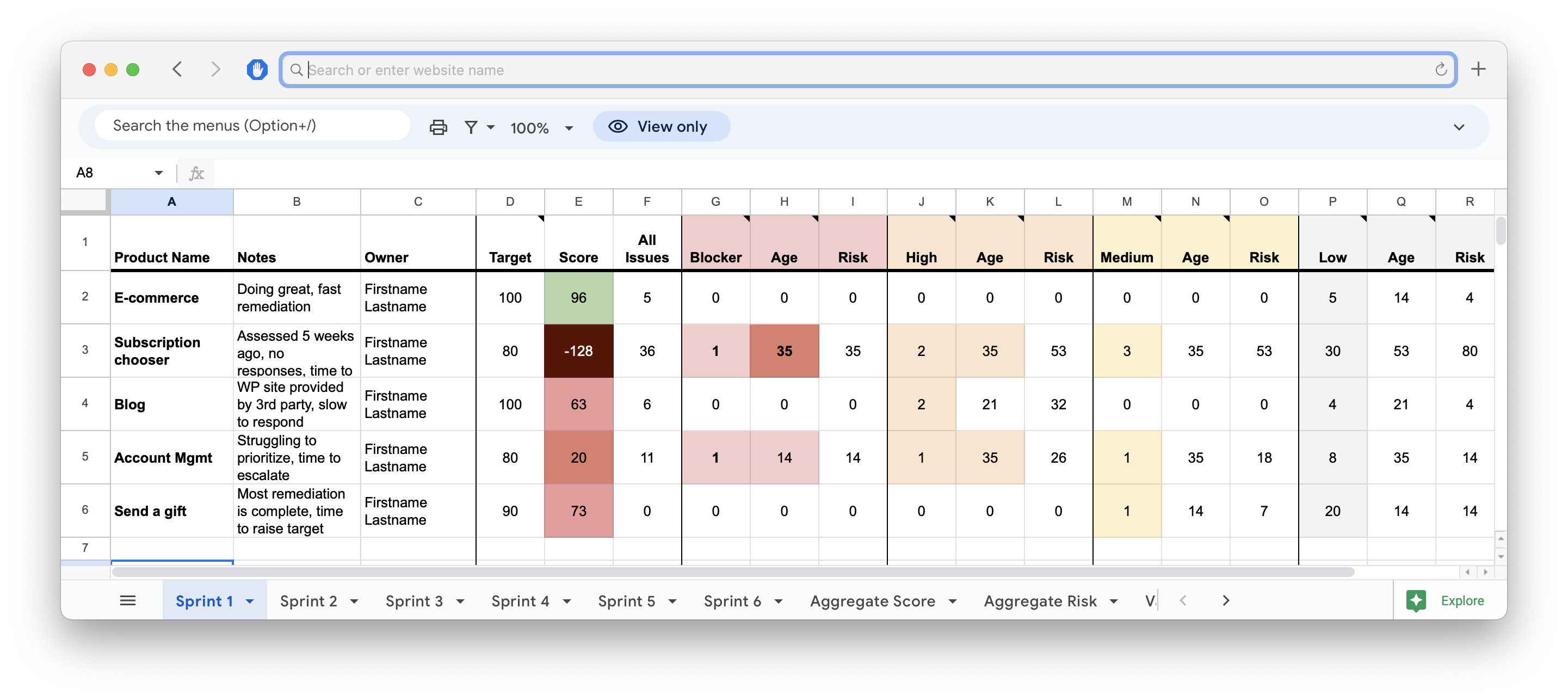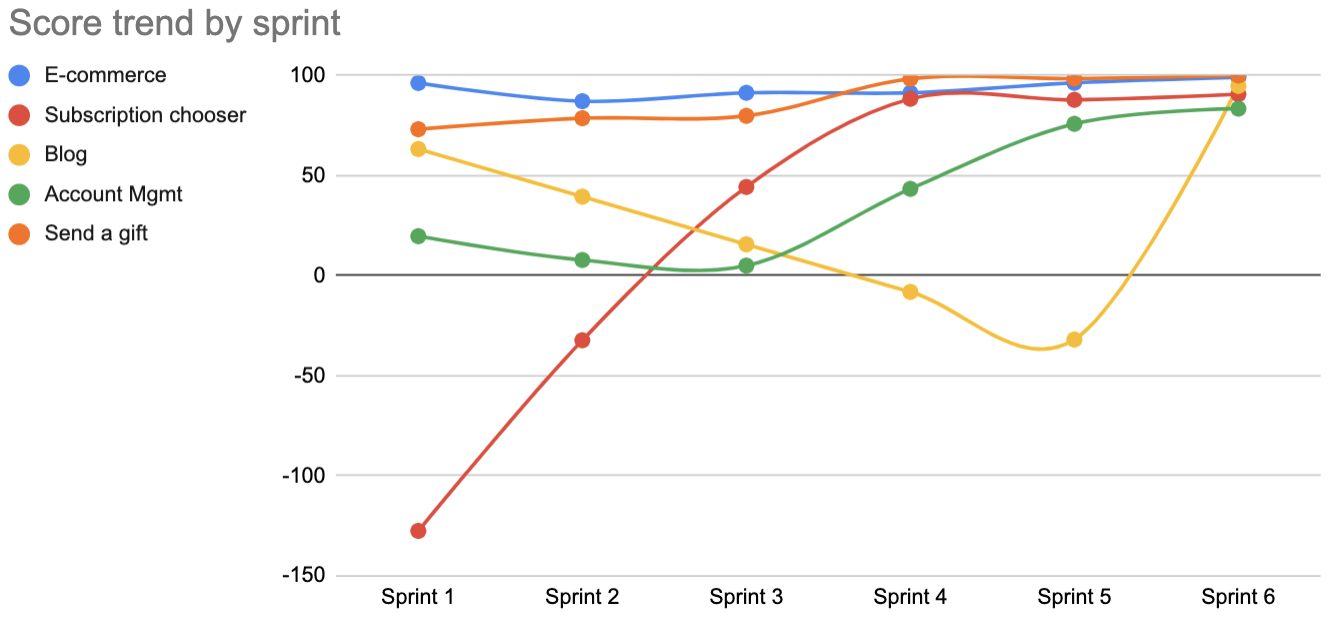Why this matters
Tactics are what an organization does to satisfy the strategic goals.
Tactics should be measurable, adaptable over time as results become evident, and reportable to leadership.
For example, inviting guest presenters to speak is one common communications tactic. When preceded and followed up by a survey on accessibility awareness, it provides reportable metrics.
Implementing an automated quality gate is another tactic. Data from that gate should be reported to leadership for praise, improvement or escalation.
It will be impossible to know if a tactic helps satisfy strategic goals without measurements. If you can’t track its use or effectiveness, you should consider prioritizing other measurable efforts.
Gathering data
If you want to be more than a resource center, gathering and reporting data is a must.
Acquire product wide accessibility assessments
There are many contractors who can provide manual and automated assessments.
Features to look for
- Manual assessment should include a spreadsheet imported into a project management system.
- Automated assessments should be produced from tools your organization can access for follow up reports.
- Ability to perform validation assessments for comparison once remediation work is complete.
Survey teams and processes for accessibility best practices
Study the processes for each component of your product. Different lines of business, deployment methods, technologies and partners all impact the way products are produced. There may not be a one-size-fits-all approach within your enterprise.
Roles to survey
Use the KPIs in each guide to survey product teams
- Design systems
- Component library
- Infrastructure and architecture
- Product owners/managers
- Copywriters
- Designers
- Developers
- CMS authors
- QA testers
Conduct focus group input sessions
By letting teams be part of focus group discussions, they will have a voice in shaping changes to their processes. It’s important for people to at least feel like their voices are heard.
These sessions also allow you to build relationships with teams so they know there is an accessibility team with points of contact.
Build a metrics dashboard for leadership
By giving leadership objective reporting data, you will have a tool that illustrates where management needs to enforce policies.
This dashboard provides a structure for having conversations
- Which teams are improving performance
- Why some teams are struggling
- Where more resources are needed
Condense defects and best practice commitment audits into a singular accessibility score into a regular schedule, likely for every product release cycle.

By tracking these scores over time, progress toward policy targets can be visualized in a dashboard.

Improve processes and maturity
With surveys complete, you’ll have a sense of what tactics are helpful.
Add accessibility as functional requirement
Accessibility is not another legal non-functional compliance requirement box to be checked as complete, like adding a disclaimer.
Accessibility should be named and accepted as a gated high-level functional requirement, just like security or performance.
There are few ways to do this by role.
- Product owners define atomic accessibility acceptance criteria.
- Developers require atomic accessibility acceptance criteria in their definition of ready and done.
- QA testers require atomic accessibility acceptance criteria to begin testing.
- Procurement must add language to contracts and working agreements that WCAG compliance is mandatory.
General and role specific training on accessibility
Work with your HR group to incorporate a reportable mandatory basic accessibility training into your onboarding process covering accessibility as a value of the company, basic accessibility etiquette, and the law.
For existing and future team members, you must identify and assign a trackable training regimen covering expectations and the basics of accessibility for each role.
Report regular training metrics to leadership.
Integrate manual and automated quality gates
Manual testing
Manual testing is precisely that: a human actually testing the experience using the screenreader and browser combinations you need to support.
Experts can deliver an organized report of defects by severity. This is a necessary tool for improving the customer experience.
Limits of manual testing
A manual test isn’t the same as a usability study, but it is effective in uncovering the issues your customers experience.
Manual testing is performed by people, and perception of what constitutes a defect can vary slightly from one tester to the next. It will be helpful for your testers to reference your severity definitions, and use uniform testing acceptance criteria.
Automated testing
Automated tests find programmatic errors, but can’t describe actual customer experiences. Just like a spell checker, automation can flag non-issues while missing legitimate problems because it can’t understand context and intention.
How to use automated scans effectively
Scanning tools quickly pinpoint syntax defects in code. Some flagged issues won’t affect the customer experience, but you should exercise scrutiny and manual testing if a web page is riddled with invalid code and errors.
Limitations of automated scans
Testing tools have value. But it’s important to understand their drawbacks. Even the most robust tools can identify less than half of the potential defects on a page.
Code can be inaccessible for a person using their keyboard or screen reader without being flagged as invalid markup by an automated tools.
Practical examples
- Automated scans can instantaneously test checkboxes for properly associated labels and other code attributes, but can’t tell you if the labels make sense.
- Automation tools can flag an image for missing alt text, but can’t tell you if it would be better for the screen reader to ignore a particular decorative icon.
- Custom components, like an accordion expander, could be inaccessible with the keyboard and yet be formed of valid code that won’t raise an error.
Offer expert accessibility coaching
It’s unrealistic to think a single training course will give developers what they need to start writing accessible code.
Training will provide a foundation for asking the right questions of the accessibility coaches.
Areas of expertise
- Inclusive UX/UI design and research
- Web UI development
- Native app development
- Content strategy
- QA testing
It’s difficult to find find all of these competencies in one expert, but I know someone.
Foster cultural change
Changing hearts and minds doesn’t require every individual to bend to your will.
If you can reach the top performers in your enterprise, they’ll help socialize and lead by example.
Produce high quality communications and events
Use existing channels
Partner with your internal communications team to find ways to communicate using existing platforms. Those teams are always looking for something new to share and can report metrics. For example, if they already produce a weekly business update video from senior leadership, find ways to integrate content there.
Ask leaders to keynote
Use leadership engagement at events to drive attendance. This will illustrate the leadership buy in you’ve achieved and reinforce that buy in with leaders.
Invite outside experts
Sometimes it’s easier to learn from someone without the baggage and weariness of your own enterprise. Invite outside presenters to speak on inclusion and accessibility.
Operate a champions program
An organized champions program is no small matter. A significant portion of a program managers time or a devoted volunteer committee will be required to form, integrate and continually operate it.
Consider all of the assets and processes that need to be created:
- Curriculum
- Coordination with team managers
- Becoming integrated into employee career ladders
- Recognition and awards
A champions program will not happen organically. These programs are an enormous amount of work and need significant collaboration with HR, managers and communications to be sustainable.